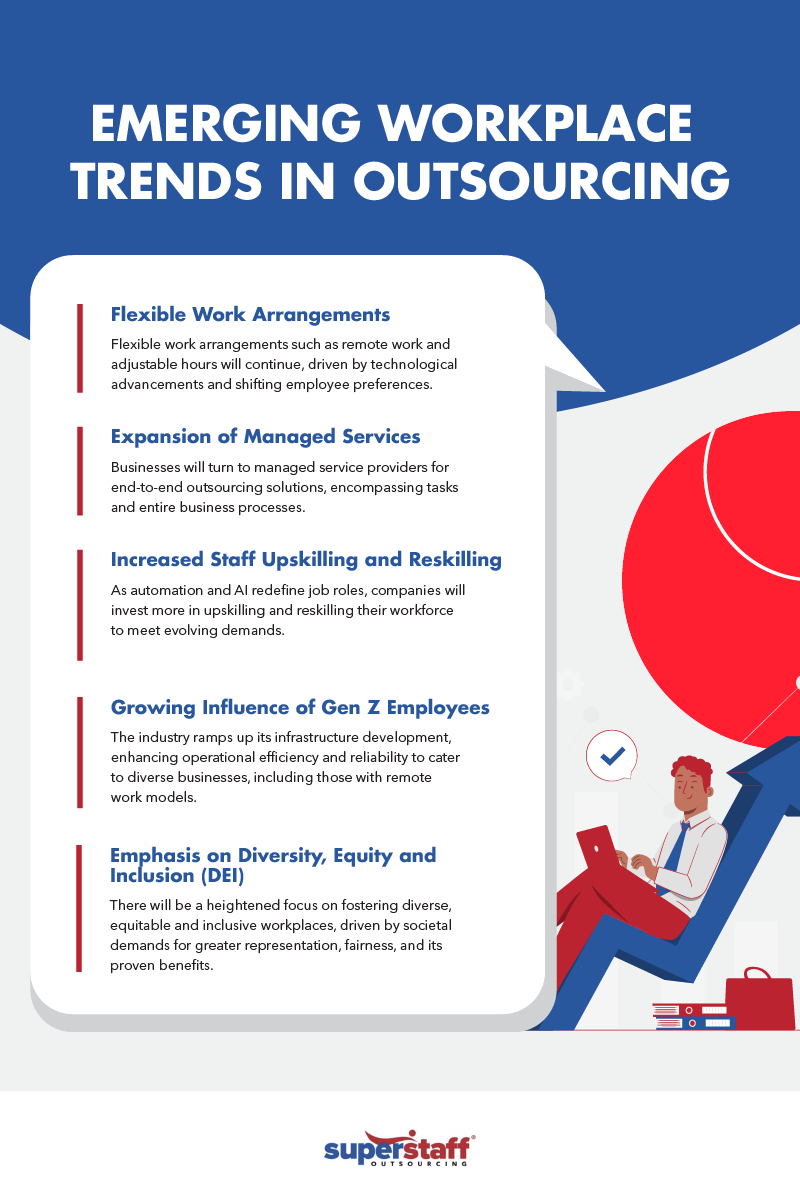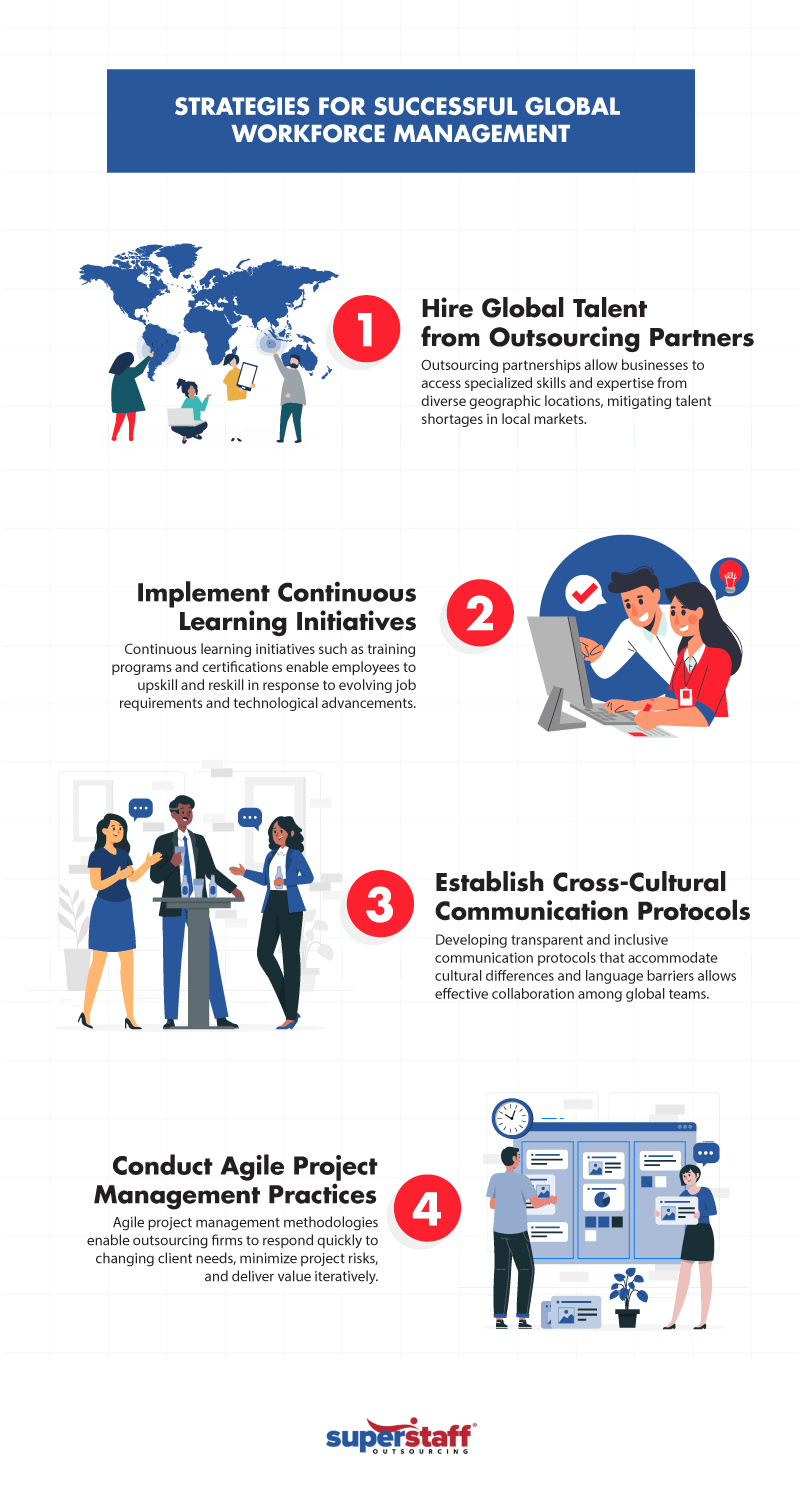
With the global workforce experiencing rapid transformations since 2023, the outsourcing industry is undergoing a transformative revolution. In a 2023 survey, the majority (65%) of company leaders worldwide said they were planning to increase their reliance on contingent workers, and 80% were already relying on them in some capacity.
However, it’s not all good news. From the same survey, 70% claimed to have experienced difficulties integrating contingent workers. Such a consistent experience hints at the need for outsourcing companies to remain agile and responsive to their partner company’s needs.
This article analyzes the global workforce trends shaping the outsourcing industry in the coming years to help businesses stay competitive in the face of such shifts.
Emerging Workplace Trends in Outsourcing
Here are the future workplace trends you can expect to shape the industry. Staying informed and ahead of these developments will be essential for navigating these changing times.

1. Flexible Work Arrangements (FWAs)
The trend of FWAs is poised to become even more prevalent as technological innovations continue to facilitate remote collaboration and virtual communication. Already, 80% of survey respondents in a recent study offer some type of it, including telework, flex time, and ad hoc working.
The increasing reliance on remote work and investment into related infrastructure offer opportunities to access both full-time and outsourced remote talent without worrying about geographical boundaries or physical office space.
2. Expansion of Managed Services
Flexible work arrangement infrastructure opens the door to the expansion of managed services for businesses looking to streamline processes and focus on core competencies. The industry is poised for significant growth, with a projected compound annual growth rate of 13.6% from 2023 to 2030.
This trend extends beyond the traditionally outsourced tasks such as IT, marketing, and customer support into human resources, finance, and other back-office tasks. As businesses increasingly embrace the managed services model, they seek providers who can offer solutions aligning with their strategic objectives and delivering measurable value.
3. Increased Staff Upskilling and Reskilling
Over 80% of businesses plan on adopting automation and AI by 2025, and many already have. It’s safe to say that tech is changing traditional job roles. The increased efficiency and reduced tasks empower companies to channel more funds into upskilling and reskilling their workforce to fill different niches. This investment addresses immediate skill gaps and develops a culture of continuous learning.
Companies prioritizing employee development are future-proofing their workforce as AI capabilities evolve. They’re also ensuring their organization can empower employees to embrace the latest cutting-edge tools on the market.
4. Growing Influence of Gen Z Employees
As increasingly more Generation Z’s join the workforce, their unique characteristics and preferences will profoundly shape workplace dynamics. In 2023, they comprised 27% of the global workforce, second only to the millennials in terms of representation. Gen Z office workers are known for their digital fluency, entrepreneurial spirit, and desire for purpose-driven work.
Companies must adapt by embracing collaborative and transparent communication platforms and aligning organizational values such as sustainability and social responsibility.
5. Emphasis on Diversity, Equity, and Inclusion (DEI)
Driven in part by Gen Z workers, the emphasis on creating diverse, equitable, and inclusive workplaces will continue as businesses recognize DEI’s tangible benefits in fostering innovation and creativity.
Simply put, diverse, multilingual teams are better equipped to comprehend and serve various customer bases, improving performance and competitiveness in the global marketplace. DEI strategies can encompass inclusive leadership, equitable opportunities for advancement, and creating a company culture where all employees feel valued and respected.
Labor Market Trends Affecting Outsourcing
Building on the discussion of workforce trends in outsourcing, it’s imperative to delve into the broader labor market dynamics shaping the industry.
1. Talent Shortages
The outsourcing industry faces mounting challenges in sourcing and retaining skilled talent, particularly in specialized fields such as technology and data analytics. In 2023, 54% of organizations experienced a shortage in tech skills despite increased hiring since the pandemic.
The U.S. Chamber of Commerce noted that even sectors facing a labor surplus, like the construction industry, still have unfilled positions due to geographic limitations. These statistics emphasize the urgency for outsourcing firms to innovate talent acquisition strategies and invest in workforce development programs to bridge skill gaps and overcome the labor shortage.
2. Wage Hikes
If the recent Hollywood strikes are anything to go by, workers across industries are increasingly vocal about their demands for fair compensation and improved working conditions. This trend extends to the outsourcing industry, where skilled professionals leverage their expertise and the previously mentioned talent shortage to negotiate higher wages and better benefits.
As outsourcing firms grapple with the implications of wage inflation, they must balance cost considerations with the imperative to attract and retain top talent. The average hourly earnings for all non-farm employees in the U.S. have risen by nearly 5% since December 2022, reflecting the growing pressure on employers to ensure equitable compensation structures.
3. Global Workforce Mobility
The increasing mobility of the global workforce presents both opportunities and challenges for outsourcing firms. On the one hand, it enables access to talent pools across borders, facilitating collaboration and creativity. On the other hand, there is the risk of geopolitical tensions, immigration policies, and cultural barriers complicating talent acquisition and project management.
Immigrants make up nearly 20% of the U.S. workforce, yet they often face numerous challenges in obtaining legal entry into countries where outsourcing firms operate. Complex visa processes, uncertainty around immigration policies, and cultural assimilation issues can hinder the smooth integration of immigrant talent into the workforce.
Consequently, outsourcing firms must navigate these challenges sensitively by supporting immigrant employees and advocating for immigration policies that promote workforce diversity and mobility.
Strategies for Successful Global Workforce Management
With so many trends pushing and pulling the global workforce and outsourcing industry, it becomes essential to form strategies to harness the full potential of these emerging factors.
1. Hire Global Talent from Outsourcing Partners
Outsourcing partners are quick and easy sources of global talent across borders. Besides specialized skills, they can also provide services in the preferred languages of your target market. Outsourced labor is also often less expensive for the same or better quality, which is the primary reason stated by 59% of companies that outsource.
The added value outsourcing can provide focuses on augmenting workforce capabilities to drive business growth. For example, providing multilingual customer service can make your products and services more accessible, which is a competitive advantage.
For instance, SuperStaff’s nearshore call centers in Colombia, customer service outsourcing in the Philippines, and U.S. call center onshore services offer access to a range of skilled professionals across different locations.
2. Implement Continuous Learning Initiatives
Job obsolescence is a central fear for 22% of U.S. workers, highlighting the critical need for organizations to invest in ongoing training and development. Fortunately, continuous learning initiatives empower employees to adapt to continuously evolving job requirements and technological advancements.
SuperStaff’s commitment to employee development includes ongoing training and professional growth opportunities, ensuring its workforce remains agile and adaptable.
3. Establish Cross-Cultural Communication Protocols
Clear and inclusive communication protocols are essential for fostering effective collaboration and understanding among diverse global teams. It enables efficient project management and client engagement, even for offshore service providers.
Companies that outsource back-office service solutions might not be fully maximizing their partnership. They can potentially enhance outcomes with some investment into infrastructure that supports it. A recent study reveals that ethnically and culturally diverse teams consistently outperform those that aren’t by as much as 48%.
SuperStaff’s diverse offshore and nearshore teams are well-versed in communicating with foreign partners, ensuring seamless collaboration and successful project outcomes in a global context.
4. Conduct Agile Project Management Practices
Agile project management was originally an approach to software development involving breaking down larger projects into smaller, more manageable tasks. This approach allows development teams to receive client feedback and adjust accordingly. As the name suggests, it’s a more malleable approach when compared to the traditional idea of outsourcing.
Outsourcing companies can break down complex projects into smaller deliverables, allowing for continuous feedback, rapid adaptation to changing client needs, and incremental value delivery. This iterative approach encourages collaboration between outsourcing firms and clients, leading to more flexible, efficient and successful project outcomes.
For example, SuperStaff utilizes similar practices to manage client projects effectively across various locations, ensuring timely delivery of high-quality solutions tailored to client needs.
Leveraging Trends to Drive Excellence
The evolving global workforce presents both challenges and opportunities for the outsourcing industry. Proactively aligning with emerging trends allows businesses to stay several steps ahead of the curve and prepare themselves for long-term success.
SuperStaff is the premier long-term partner for businesses looking to outsource to the Philippines. We understand the importance of adjusting to these trends and are committed to helping companies drive excellence no matter the circumstance. Contact us today to learn how we can tailor our services to your needs.







